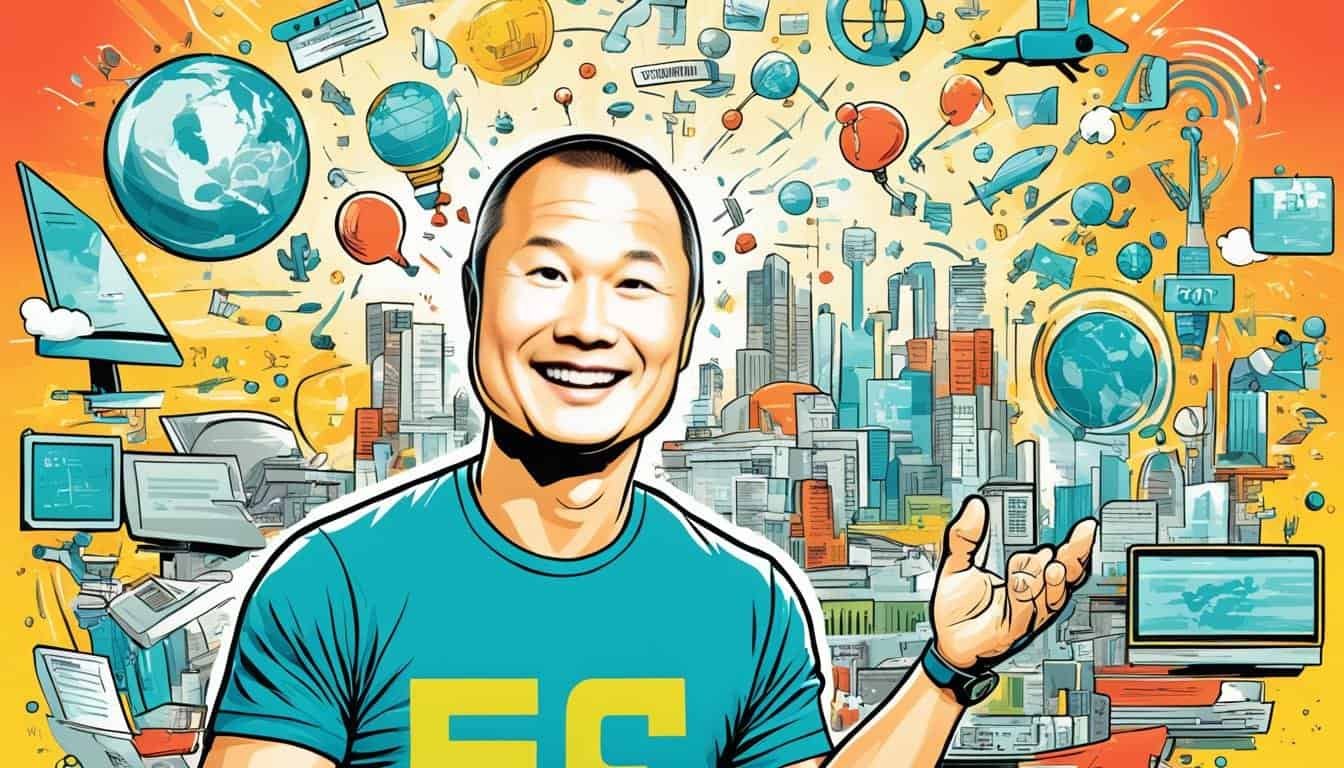Embracing Change: Lessons from Tony Hsieh
“The biggest risk is not taking any risk… In a world that is changing quickly, the only strategy that is guaranteed to fail is not taking risks.” – Mark Zuckerberg
Tony Hsieh, the former CEO of Zappos, has left behind a legacy of valuable lessons on leadership, innovation, and creating a thriving company culture. As an entrepreneur and visionary, Hsieh revolutionized the e-commerce industry with his customer-centric approach and commitment to employee empowerment. His insights continue to inspire and guide businesses worldwide, offering a roadmap for success in an ever-evolving marketplace.
Key Takeaways:
- Embrace change and take risks to stay relevant in a rapidly changing world.
- Prioritize exceptional customer service to build strong relationships and differentiate your business.
- Foster a strong company culture centered around core values to create a positive work environment.
- Empower employees and give them ownership of their roles to drive engagement and productivity.
- Balance profitability with a larger purpose to create meaningful impact and attract like-minded customers.
The Importance of Company Culture
Tony Hsieh, the former CEO of Zappos, firmly believed in the power of company culture as a driver of long-term success. He understood that a strong culture not only shapes the employees’ experience but also impacts customer satisfaction. By building a culture centered around core values and fostering employee engagement, businesses can create a positive and thriving work environment.
According to Tony Hsieh, a strong company culture starts with defining and embracing core values. At Zappos, these core values included delivering “wow” through service, embracing change, and being adventurous. These values not only shaped the behavior of employees but also influenced the decision-making process.
“Our belief is that if you get the culture right, most of the other stuff like delivering great customer service or building a long-term brand or empowering passionate employees and customers will happen naturally on its own.”
To ensure that these core values are not just empty words but deeply ingrained in the organization, Zappos introduced a culture book, which contains stories and examples of employees living these values. This book, created and maintained by employees, serves as a source of inspiration and helps reinforce the company culture.
One important aspect of building a strong company culture, according to Tony Hsieh, is the emphasis on employee engagement and happiness. He believed that employees who are engaged and happy are more likely to go above and beyond for customers. Building a culture that prioritizes employee well-being and fosters a sense of belonging can lead to increased employee satisfaction, productivity, and ultimately improved customer experiences.
To foster employee engagement, Zappos implemented unique practices, such as offering new hires $2,000 to quit after the first week of training. This initiative, known as the “offer,” ensures that only those truly aligned with the company culture and values remain part of the organization.
Another way Zappos fostered employee engagement was by providing opportunities for growth and development. They encouraged employees to take ownership of their roles and empowered them to make decisions. Recognizing and rewarding employees for their contributions created a sense of ownership and accountability, leading to a more engaged workforce.
Zappos’ focus on building a strong company culture not only led to happier employees but also greater customer loyalty. Customers resonated with Zappos’ core values and exceptional service, driving repeat business and positive word-of-mouth.
Benefits of a Strong Company Culture
A strong company culture has numerous benefits, including:
- Higher employee satisfaction and engagement
- Lower turnover rates
- Improved customer experiences and loyalty
- Enhanced innovation and creativity
- Attracting top talent
- Positive brand reputation
In conclusion, Tony Hsieh’s emphasis on building a strong company culture serves as a valuable lesson for businesses. By fostering a culture centered around core values and prioritizing employee engagement and happiness, businesses can create a positive and thriving work environment that ultimately benefits both employees and customers.
Customer Service as a Priority
Tony Hsieh, the former CEO of Zappos, recognized the significance of delivering exceptional service and going above and beyond for customers. He understood that outstanding customer service is key to creating loyal customers and building strong relationships.
Hsieh’s approach to customer service was rooted in offering convenience and satisfaction to customers. Zappos provided free shipping and returns, ensuring a hassle-free experience for shoppers. With a 24/7 customer support team, customers could reach out for assistance at any time. Additionally, Zappos implemented a generous return policy, instilling confidence in customers and removing barriers to purchase.
“We take most of the money that we could have spent on paid advertising and instead put it back into the customer experience. Then we let the customers be our marketing ‘team’.” – Tony Hsieh
By prioritizing exceptional customer service like Hsieh, businesses can differentiate themselves from competitors and create a customer-centric culture. Going the extra mile and exceeding customer expectations not only fosters loyalty but also generates positive word-of-mouth, leading to organic growth and brand advocacy.
Exceptional customer service involves active listening, understanding customer needs, and providing personalized solutions. When customers feel valued and cared for, they are more likely to become repeat customers and recommend the brand to others.
Benefits of Delivering Exceptional Service:
- Customer loyalty and retention
- Positive brand reputation and word-of-mouth marketing
- Increase in customer lifetime value
- Differentiation from competitors
- Opportunities for upselling and cross-selling
Investing in customer service training and empowering employees to go the extra mile can significantly impact a company’s success. By adopting Tony Hsieh’s customer service mindset, businesses can build strong customer relationships and thrive in today’s competitive landscape.
Employee Engagement
Tony Hsieh, the visionary former CEO of Zappos, understood the tremendous impact of employee happiness and engagement on overall business success. He firmly believed that fostering a sense of ownership and accountability among employees leads to higher job satisfaction and productivity, ultimately driving customer satisfaction and loyalty.
To achieve this, Hsieh focused on hiring individuals who align with the company’s culture and empowering them to take ownership of their roles. By giving employees the freedom to make decisions and recognizing their contributions, businesses can create a work environment that inspires passion, creativity, and innovation.
“When you give employees the freedom to make their own decisions and trust that they will do what is right, amazing things happen. It’s about empowering them to take ownership and be accountable for their work.”
One of Hsieh’s key strategies for empowering employees was to create a flat organizational structure, where hierarchies were minimized. This enabled employees at all levels to feel a sense of ownership and have a direct impact on the company’s success. By removing traditional barriers and encouraging open communication, businesses can foster a collaborative and inclusive work culture that empowers employees to take initiative and contribute their unique perspectives.
To further enhance employee engagement, a strong emphasis should be placed on fostering employee happiness. Hsieh recognized that happy employees are more motivated, creative, and productive. By prioritizing employee well-being, businesses can create a positive work environment that cultivates growth and success.
Ownership and Accountability
Hsieh believed that ownership and accountability are essential components of a thriving work culture. When employees feel a sense of ownership, they are more likely to take initiative, make decisions that align with the company’s goals, and go above and beyond to deliver exceptional results. By encouraging employees to think and act like owners, businesses can foster a culture of responsibility and excellence.
“I wanted employees to feel like they were running their own business within the greater organization. This sense of ownership and accountability inspires individuals to push themselves and the company forward.”
Moreover, Hsieh believed in recognizing and celebrating employee contributions. By acknowledging their achievements and providing opportunities for growth, businesses can reinforce a culture of ownership and accountability, motivating employees to continue performing at their best.
Fostering Employee Happiness
Happiness was one of the core values at Zappos, and Hsieh understood that it played a crucial role in employee engagement. He believed that happy employees are more likely to provide exceptional service to customers, resulting in higher customer satisfaction and loyalty.
Businesses can foster employee happiness by creating a supportive and inclusive work environment. This includes providing opportunities for personal and professional growth, implementing work-life balance initiatives, and offering meaningful rewards and recognition.
By prioritizing employee empowerment, happiness, and ownership, businesses can create a work culture that attracts and retains top talent, drives customer satisfaction, and ultimately leads to long-term success.
The Happiness Framework
Tony Hsieh, the former CEO of Zappos, introduced the concept of the Happiness Framework, which consists of four pillars: perceived control, perceived progress, connectedness, and vision or meaning in life. This framework, rooted in achieving personal growth and development, can be applied both personally and professionally to unlock greater fulfillment.
Perceived control refers to having a sense of autonomy and influence over one’s own life, work, and decisions. It empowers individuals to take ownership of their responsibilities and shape their future.
Perceived progress is the belief that one is continuously making strides towards their goals, whether big or small. It involves setting meaningful objectives, tracking progress, and celebrating achievements along the way.
Connectedness emphasizes the importance of building and nurturing meaningful relationships, both within and outside of the workplace. Fostering connections with colleagues, customers, and the broader community creates a sense of belonging and purpose.
Vision or meaning in life entails having a clear sense of purpose and direction. It involves identifying personal values, aligning them with professional pursuits, and working towards a larger vision that transcends individual goals.
By embracing the Happiness Framework and focusing on personal growth and development, businesses can create an environment where employees feel valued, empowered, and fulfilled in their work. This not only leads to increased productivity and innovation but also cultivates a positive and thriving organizational culture.
Key Takeaways:
- The Happiness Framework consists of perceived control, perceived progress, connectedness, and vision or meaning in life.
- Applying the Happiness Framework promotes personal growth and development.
- Businesses can create an empowering environment by embracing the pillars of the Happiness Framework.
References:
- Hsieh, T. (2010). Delivering Happiness: A Path to Profits, Passion, and Purpose. Business Plus.
| Pillar | Description |
|---|---|
| Perceived Control | A sense of autonomy and influence over one’s life and work |
| Perceived Progress | Continuous growth and achievement of meaningful goals |
| Connectedness | Nurturing meaningful relationships and fostering a sense of belonging |
| Vision or Meaning in Life | Having a clear sense of purpose and direction |
Lessons from Failure
In the journey to success, failure is often seen as a setback or a roadblock. However, Tony Hsieh, the former CEO of Zappos, believed in embracing failure as a valuable learning opportunity.
Hsieh openly shared his experiences with previous failed ventures and encouraged individuals and businesses to take risks without fear. He understood that failure is not the end but a stepping stone to success.
By embracing failure, businesses can foster a culture of innovation and continuous improvement. It is through failure that new ideas are born, and valuable lessons are learned. Failure allows us to see what works and what doesn’t, guiding us towards better strategies and approaches.
Embracing failure is not about celebrating mistakes, but rather understanding that failure is an essential part of the journey. It is an opportunity to reassess, learn, and grow.
Learning from failure requires a mindset shift. Instead of being paralyzed by the fear of failure, individuals and businesses must view failure as an opportunity for growth and development.
Hsieh’s approach to risk-taking revolutionized the business world. He believed that taking risks is necessary for achieving extraordinary results. It is through calculated risks that breakthroughs happen and boundaries are pushed.
By taking risks, businesses can explore new territories, uncover untapped potential, and seize opportunities that others may miss. Risk-taking is the catalyst for innovation and progress.
Balancing Profitability with Purpose
When it comes to building a successful business, Tony Hsieh believed in finding a delicate balance between profitability and purpose. He understood that businesses that prioritize creating a meaningful impact and delivering happiness can thrive in the long run.
By aligning their business goals with a larger purpose, companies can attract customers that resonate with their values. This not only fosters customer loyalty but also creates a positive social impact.
For Tony Hsieh, success was not solely measured by financial gains. He believed in the power of purpose-driven businesses to make a difference in the world. By focusing on creating a meaningful impact, companies can leave a lasting legacy that goes beyond mere profitability.
“Profitability is important, but so is leaving a meaningful impact on the world. Balancing these two aspects is what truly defines a successful and purpose-driven business.”
– Tony Hsieh
While profitability ensures the sustainability of a business, having a clear purpose provides a deeper motivation for both employees and customers. This sense of purpose drives innovation and inspires individuals to go above and beyond in their work.
To achieve this balance between profit and purpose, businesses must adopt a customer-centric approach. Understanding the needs and aspirations of their target audience allows companies to create products and services that make a genuine difference in people’s lives.
Ultimately, the success of a purpose-driven business goes beyond financial gains. It lies in the satisfaction of making a positive impact on the world and leaving a meaningful legacy. As Tony Hsieh demonstrated throughout his career, balancing profitability with purpose is the key to creating a thriving and sustainable business.
Creating a Purpose-Driven Business
Here are a few strategies to help businesses balance profitability with purpose:
- Define your purpose: Clearly articulate the purpose and values that drive your business. This will guide decision-making and ensure alignment across all aspects of the organization.
- Engage employees: Foster a sense of purpose and belonging among employees by involving them in the company’s mission and empowering them to contribute their ideas and insights.
- Align with social causes: Identify social causes and initiatives that align with your business values and actively support them. This allows you to make a positive impact on society while strengthening your brand reputation.
- Measure impact: Develop key performance indicators (KPIs) that measure both financial performance and social impact. This will help monitor progress and ensure that the business remains focused on its purpose.
By following these strategies, businesses can build a purpose-driven organization that not only generates profits but also creates a meaningful impact on society.
The Evolving Role of Workplace Leadership
When it comes to leadership, Tony Hsieh believed in the power of evolution. He recognized that the traditional hands-on management approach was no longer effective in today’s dynamic work environment. Instead, Hsieh advocated for a more hands-off and empowering style of leadership. By providing a solid infrastructure for employees to grow and encouraging managers to set frameworks that give employees freedom and autonomy, businesses can foster a culture of innovation and creativity.
Empowering employees and allowing them to take ownership of their work is key to unleashing their full potential. When individuals feel trusted and valued, they are more likely to take risks, think outside the box, and contribute their unique ideas and perspectives. This hands-off management approach not only boosts employee morale and satisfaction but also drives business results.
“A good leader takes a little more than his share of the blame, a little less than his share of the credit.”
By adopting a hands-off management style, leaders demonstrate their trust in their team members’ abilities and create an environment where employees feel empowered to make decisions and take on leadership roles themselves. This not only relieves the burden on managers but also cultivates a sense of ownership and accountability among employees. When individuals are given the freedom to make choices and have a stake in the success of their work, they are more likely to be motivated, engaged, and committed to achieving excellence.
Furthermore, an evolving leadership role goes hand in hand with the concept of managerial empowerment. Rather than micromanaging every aspect of their team’s work, managers should focus on guiding and supporting their employees. By providing the necessary resources, training, and mentorship, managers can empower their team members to take ownership of their work and develop their skills and expertise.
Empowering Leadership in Action: The Zappos Model
A prime example of empowering leadership is evident in Tony Hsieh’s tenure as the CEO of Zappos. Under his leadership, Zappos became renowned for its unique company culture and employee-centric approach. Hsieh built a culture that valued and empowered employees, allowing them to excel in their roles and create exceptional customer experiences.
The image below showcases the evolution of Tony Hsieh’s leadership role:
| Traditional Leadership Role | Evolving Leadership Role |
|---|---|
| Micro-management | Hands-off approach |
| Command and control | Empowerment and autonomy |
| Focus on tasks | Focus on growth and development |
| Centralized decision-making | Decentralized decision-making |
This shift in leadership style enabled Zappos to cultivate a highly motivated and engaged workforce, resulting in exceptional customer service and business success.
In conclusion, embracing the evolving role of workplace leadership is crucial in today’s fast-paced and ever-changing business landscape. By adopting a hands-off management approach and empowering employees, businesses can create a culture that fosters innovation, creativity, and personal growth. Tony Hsieh’s insights remind us of the power of trust, autonomy, and accountability in driving individual and organizational success.
Work-Life Integration
When it comes to achieving a fulfilling and balanced life, Tony Hsieh believed in breaking traditional barriers and embracing work-life integration. He recognized the importance of blending work and personal life, creating a flexible work environment that allows employees to integrate their work with the people they want to be with and the life they want to live.
By reconsidering the traditional boundaries between work and personal life, businesses can create a work environment that fosters happiness and fulfillment. Tony Hsieh’s non-traditional approach revolutionized the concept of work-life balance, emphasizing the need for flexibility and adaptability in today’s fast-paced world.
By creating a culture that embraces work-life integration, businesses can empower their employees to design their own schedules, prioritize their personal needs, and achieve a better work-life harmony. This not only leads to increased employee satisfaction and happiness but also promotes productivity and creativity.
Work-life integration not only benefits employees but also positively impacts the overall success of a business. When employees have the freedom to integrate their personal lives with their work, they are more likely to be motivated, engaged, and committed to their roles. This, in turn, results in higher levels of innovation, collaboration, and ultimately, business growth.
Benefits of Work-Life Integration
- Improved Employee Well-being: By allowing employees to seamlessly blend work and personal life, businesses can contribute to their overall well-being and happiness.
- Increased Productivity: Work-life integration promotes a healthier work-life balance, reducing burnout and increasing employee productivity.
- Enhanced Employee Engagement: When employees have control over their work schedules and the flexibility to manage personal commitments, they feel more engaged and committed to their work.
“Work-life integration is about finding harmony between work and personal life, allowing employees to be present in both areas without sacrificing one for the other.”
Businesses can support work-life integration by implementing policies and practices that promote flexibility, such as flexible work hours, remote work options, and support for personal commitments. By prioritizing work-life integration, businesses can create a culture that attracts and retains top talent, fostering a positive and fulfilling work environment.
The Future of Work
In today’s rapidly changing business landscape, the future of work is a topic of great significance. Tony Hsieh, the visionary former CEO of Zappos, understood the importance of embracing technology and maximizing employee freedom to stay competitive and meet the evolving needs of customers.
By embracing technology, businesses can unlock new opportunities and enhance efficiency. Automation and digitalization have become vital components of the modern workplace, enabling organizations to streamline processes, improve productivity, and deliver superior results. Tony Hsieh foresaw this shift and recognized the value of leveraging technology to drive innovation and sustainable growth.
However, embracing technology is just one aspect of shaping the future of work. Tony Hsieh emphasized the significance of maximizing employee freedom in creating a thriving work environment. He believed in allowing employees to have the autonomy to make decisions, take ownership of their roles, and explore their full potential.
“Empowerment is the key to unlocking the full potential of your team members. By granting them freedom and ensuring they have the necessary tools and resources, you create an environment where creativity thrives and extraordinary outcomes are achieved.” – Tony Hsieh
When employees have the freedom to innovate and experiment, they can contribute their unique perspectives and ideas. This not only fosters a culture of creativity and collaboration but also enables businesses to adapt and respond to emerging challenges and opportunities.
The future of work is also shaped by the evolving demands of a globalized and interconnected world. Tony Hsieh understood the importance of creating an environment that adapts to these changing demands. By promoting flexible work arrangements, businesses can attract top talent and accommodate the diverse needs and preferences of their employees.
Additionally, fostering an environment that values work-life integration is crucial in ensuring employee well-being and satisfaction. Tony Hsieh recognized the need to break free from traditional work boundaries and create a flexible work environment where employees can thrive both professionally and personally.
Key Elements Shaping the Future of Work:
- Embracing technology and leveraging its potential for innovation and efficiency.
- Maximizing employee freedom and autonomy to stimulate creativity and ownership.
- Adapting to the changing demands of a globalized and connected world.
- Promoting flexible work arrangements and work-life integration.
As we move forward, it is essential for businesses to embrace the future of work and incorporate these key elements into their strategies. By doing so, they can stay competitive, attract top talent, and drive long-term success in a rapidly evolving business landscape.
The Importance of Self-Criticism and Passion
Tony Hsieh, the former CEO of Zappos, was a strong advocate for self-criticism and remaining passionate in one’s mission as a business owner. He believed that these qualities were essential for personal growth and for driving innovation within an organization.
Remaining passionate is about not settling for the status quo and constantly striving for improvement. Hsieh believed that passion fuels creativity and pushes individuals to think beyond traditional roles. By fostering a culture of passion, businesses can inspire their employees to embrace new ideas and approaches that lead to meaningful change.
However, Hsieh also recognized the importance of self-criticism in business. He encouraged individuals to challenge their own beliefs and assumptions, constantly asking questions and seeking improvement. Self-criticism allows entrepreneurs and business leaders to identify areas for growth and make necessary adjustments to strategies.
“It’s important to always be questioning and challenging what you think you know. Look for opportunities to improve and don’t be afraid to admit when you’re wrong.”
Hsieh believed that self-criticism should extend beyond personal growth and should be applied to the overall business strategy. By evaluating the effectiveness of current practices and being open to change, businesses can adapt to the evolving market dynamics and stay ahead of the competition.
To illustrate the value of self-criticism and remaining passionate, let’s take a look at a few real-life examples:
Example 1: Tesla
Tesla, led by Elon Musk, has revolutionized the automotive industry through its innovative electric vehicles. Musk’s unwavering passion for sustainable transportation has been a driving force behind the company’s success. Additionally, Tesla’s commitment to self-criticism has led to continuous improvements in their electric vehicle technology, pushing the boundaries of what was thought possible.
Example 2: Apple
Apple, under the leadership of Steve Jobs, was known for its relentless pursuit of excellence and innovation. Jobs’ passion for creating user-friendly, beautifully designed products revolutionized the technology industry. At the same time, Apple’s culture of self-criticism helped them identify and address potential flaws in their products, ensuring they were delivering the best possible user experience.
By embracing self-criticism and remaining passionate, businesses can challenge the status quo, think beyond traditional roles, and continuously innovate. These qualities will enable organizations to adapt to change, drive growth, and achieve long-term success in today’s dynamic business environment.
Conclusion
Tony Hsieh’s legacy provides valuable lessons for businesses seeking to implement change and create a thriving company culture. By embracing his insights on leadership, innovation, and customer-centric approaches, businesses can transform their approach and achieve long-term success. Tony Hsieh’s courage and willingness to challenge traditional norms serves as a reminder that success comes from embracing change and creating a vision for a better future.
Through Tony Hsieh’s experiences, we have learned the importance of prioritizing exceptional customer service, fostering employee engagement, and creating a strong company culture. By following his lead, businesses can build meaningful connections with their customers and empower their employees to take ownership and drive success.
Implementing change in business requires a commitment to continuous improvement and a willingness to take risks. Tony Hsieh’s lessons teach us to think beyond traditional roles and to view failure as an opportunity for growth. By integrating these lessons into our own business practices, we can adapt to the changing demands of the future and maximize our potential for success.








